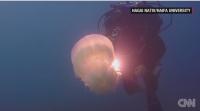 In 1869, the Suez Canal changed the world of shipping. By providing steamers a shortcut though the relatively less windy Mediterranean Sea as well as ensuring access to coaling stations, the canal destroyed the millennia long supremacy of sail. Now, the canal is providing another sort of shortcut, allowing invasive species from the Red Sea to swim into the Mediterranean.
In 1869, the Suez Canal changed the world of shipping. By providing steamers a shortcut though the relatively less windy Mediterranean Sea as well as ensuring access to coaling stations, the canal destroyed the millennia long supremacy of sail. Now, the canal is providing another sort of shortcut, allowing invasive species from the Red Sea to swim into the Mediterranean.
This summer, swarms of stinging nomad jellyfish appeared on beaches in Israel and the Eastern Mediterranean. The nomad jellyfish began migrating through the canal in 1970s and continues to spread. The jellyfish is only one sign of a far greater problem. Other invasive species, native to the Pacific Ocean and Red Sea, have also made their way through the canal, including the marbled rabbitfish, two-spot cardinalfish, the devil firefish, the silver-cheeked toadfish, and striped eel catfish. Lacking natural predators, these invasive species are spreading rapidly, displacing indigenous sea life.
For many years, the Great Bitter Lake in the canal, where the water tended to be saltier, provided a limited obstacle to invasive species. Canal expansion over the last few decades has effectively done way with this natural barrier.
This month, the Suez Canal Authority opened an expanded canal featuring a 35 kilometer (22 mile) new section of canal parallel to the existing 145-year-old waterway, as well deepening and widening sections of the existing canal. The recently completely expansion may make the problem of invasive species even worse.
